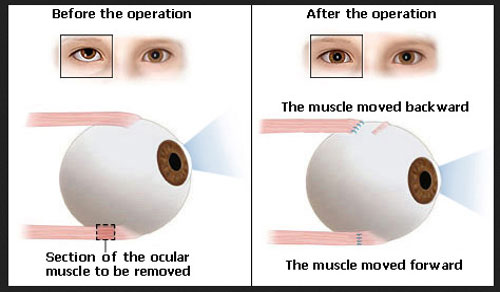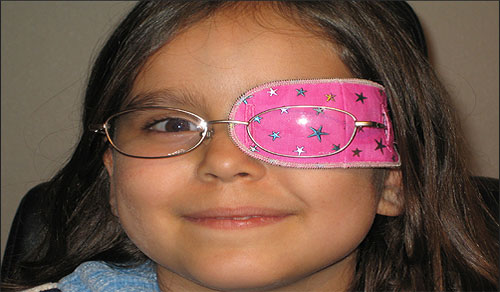Lazy eye, or more medically known as strabismus, is a condition in which the eyes are not aligned each other. According to some studies, lazy eye is usually caused by lack of coordination of the extraocular muscles so that the patient often has a binocular vision problem. The signs are both eyeballs move together so that it will make poor eye perception of distance.
Based on the researches, there are two main conditions of eyes so that they are called as a lazy eye such as Amblyopia and Strabismus, or “crossed eyes”. What is the difference both of them?
Amblyopia and Strabismus Difference
Amblyopia is a condition of eyes that are anatomically normal however the imaginative and prescient vision is abnormal. This could be as a result of refractive errors, like extreme farsightedness and nearsightedness or astigmatism, which are not revised early.
The treatment of Amblyopia is considered success and giving best result when it is carried out early life especially when adults are no more than 10 years old.
What Are the Effects of Lazy Eye?
Lazy eye indeed looks not serious problem because it does not hurt the patients. But, it has to be noted that it will cause some serious problems for your visions such as:
- It will make your lazy eyes lose a visual acuity if they are not corrected as soon as possible.
- Lazy eye will lose a binocular vision that causes the inability to quantify the depth.
- And the most serious problem is that you will lose your vision forever if the lazy eyes are not corrected and progressively unused.
I believe that you will not wish to lose your vision. Therefore, if you have lazy eye, it is suggested for you to have it corrected as soon as possible.
How to Correct a Lazy Eye: Surgery and Naturally
There are two options to fix the lazy eye; with surgery or naturally. If the option of Lazy Eye surgery is your final decision, you have to keep in mind that the result of lazy eye surgery can cause the other serious problem like neurological deficit if it is not done well. And the procedure is typically performed only on the muscles beyond the eyes. Therefore, before deciding to take a Lazy Eye Surgery, you should have already had intensive communication with your surgeon.
Even Dr. Leonard J. Press, FAAO, FCOVD suggested that every patient whose lazy eye did not need to be hurry up in getting lazy eye surgery because the surgery won’t give as much improvement as when they were younger.
“Treatment of amblyopia after the age of 17 is not dependent upon age, but requires more effort including vision therapy. It’s been proven that a motivated adult with strabismus and/or amblyopia who works diligently at vision therapy can obtain meaningful improvement in visual function. As my adult patients are fond of saying: “I’m not looking for perfection; I’m looking for you to help me make it better”. It’s important that eye doctors don’t make sweeping value judgments for patients. Rather than saying “nothing can be done”, the proper advice would be: “You won’t have as much improvement as you would have had at a younger age; but I’ll refer you to a vision specialist who can help you if you’re motivated.”
How to Fix a Lazy Eye without Surgery
Not all people prefer to take lazy eye surgery, some people may be afraid of being under knife. Therefore, they seek more information about how to cure a lazy eye without surgery. Here are some possible natural treatments that you may consider. Let’s check them out!
- Patching: it is a method to cure the lazy eye in which the therapy can be done by covering one eye for a certain period of time. This method is believed to encourage the lazy eye to work precisely. After having covered one eye for a few weeks, the lazy eye will be able to focus by itself.
- Medication Therapy: This method can be done with the use of eye drops like Atropine eye drops to make the good eye blur, so that the lazy eye will be forced to work as well as possible. However, it is important for you to know the side effects of the use eye drops such as eye irritation, making the skin around the eyes reddening, and headaches. Therefore, if you decide to fix a lazy eye without surgery, there must be a right person to control it.
Well, you have known about the way how to fix a lazy eye with or without surgery. So, the decision is your personal right. However, if you wish to have lazy eye surgery, you might need more information like cost of lazy eye surgery and its recovery.
How Much Is Lazy Eye Surgery
There are many typical of cost of lazy eye surgery. They depend on how you will pay for your lazy eye surgery whether to use insurance or not.
For the patients with health insurance usually get a discount 10%-50% of the whole costs of lazy eye surgery like doctor visit and prescription drug copays or coinsurance.
On the other hand, the cost of lazy eye surgery for the patients without health insurance depends on what type of eyes treatment which they will take. If you just need lazy eye treatment, it usually costs less than $1,000 for glasses and monitoring.
However, if you take more treatments like vision therapy to make the eyes straightened properly, you need to pay up to $2,000. Or you may even take a complex lazy eye surgery, so you need to prepare for about $5,000-$15,000. Here are the lists of lazy eye surgery cost based on the clinics.
- A University of Texas Southwestern Medical Center, study, overcharges $4,250 per case of lazy eye surgery
- Baptist Memorial Health Care, in Tennessee, Overcharges for about $5,500. It does not include the surgeon fee and it can swell depending on the complexity of the surgery.
- Saint Elizabeth Regional Medical Center, in Nebraska, charges for the lazy eye surgery for about $14,000. It also does not include doctor fee.
Lazy Eye Surgery Recovery Time
For the patients of lazy eye surgery do not need to worry about the recovery time for their surgery because whenever the surgery has been done, they will be sent to recovery area from the operating room. When you’ve awakened from the anesthesia and your surgeon or nurse already allows you to go home, then you can immediately go back to your home.
One thing that you have to remember for lazy eye surgery recovery time is that you have to always keep your eyes from the dirt and infection. The surgeon should have prescribed an antibiotic eye drop or ointment as a preventive measure. Do not ever try to rub your eyes for some days after your eye muscle surgery.


